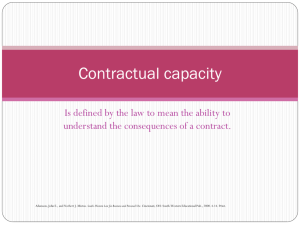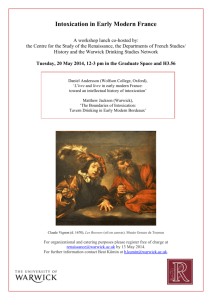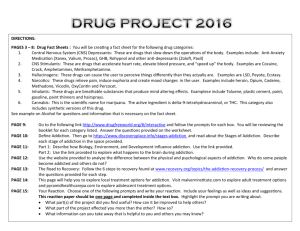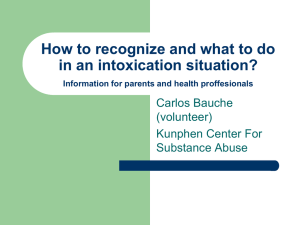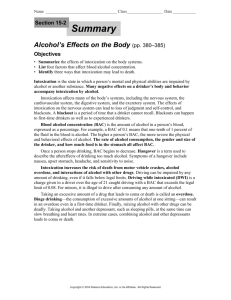Course Handbook 2012-13 - School of Social and Political Science
advertisement
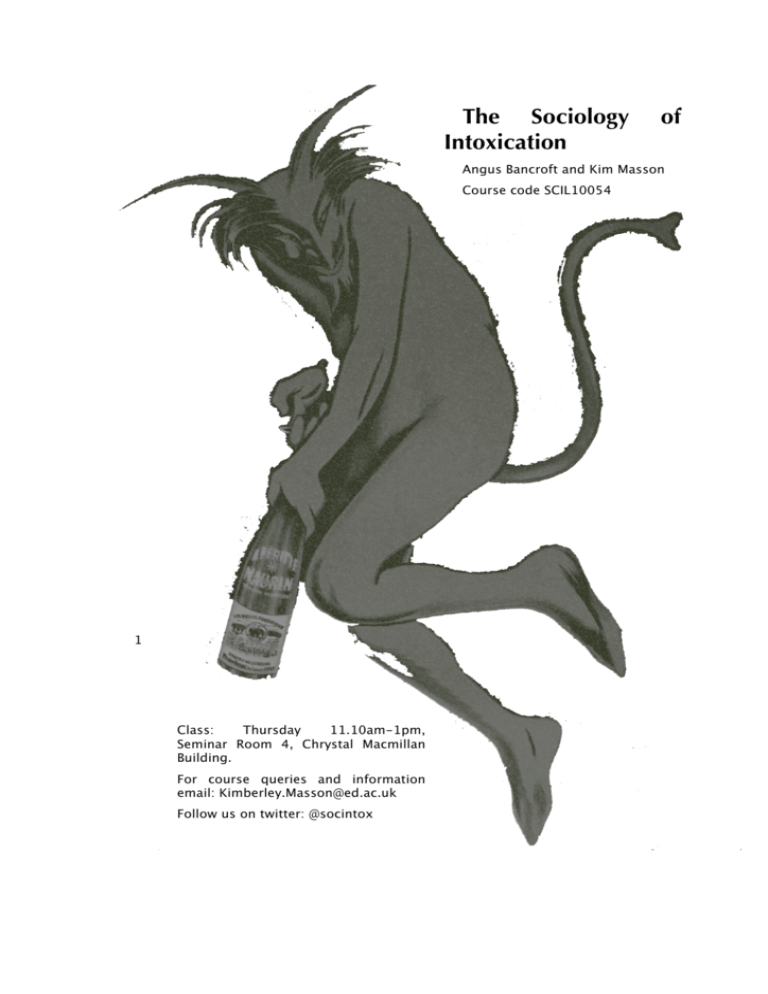
The Sociology Intoxication of Angus Bancroft and Kim Masson Course code SCIL10054 1 Class: Thursday 11.10am-1pm, Seminar Room 4, Chrystal Macmillan Building. For course queries and information email: Kimberley.Masson@ed.ac.uk Follow us on twitter: @socintox About the course ............................................................................................................. 4 Aims ............................................................................................................................................ 4 Readings ...................................................................................................................................... 5 Zotero Shared Course Library ..................................................................................................... 5 Homework ................................................................................................................................... 6 Twitter ......................................................................................................................................... 6 Class conduct ............................................................................................................................... 6 Communication ........................................................................................................................... 6 Lecture Outline ............................................................................................................... 7 1. Introduction: How Drugs Become Drugs ................................................................................ 7 2. Cultures of Intoxication ........................................................................................................... 7 3. Ritual, Distinction and Obligatory Intoxication ...................................................................... 8 4. Drug Problems or Problem Drugs? ......................................................................................... 8 5. Addiction – Triumph of Body over Mind?.............................................................................. 9 Field Trip to Crew ..................................................................................................................... 10 6. Alcohol and Economies of Pleasure ...................................................................................... 10 7. Psychedelics and Waking Dreams......................................................................................... 11 8. Heroin, Crack and Street Ethnography .................................................................................. 11 9. Prohibition, Drug Control and Cognitive Liberty ................................................................. 12 10. Conditioning, Medicalisation and Enhancement ................................................................. 12 Assessment ..................................................................................................................... 14 Online Journal ........................................................................................................................... 14 Long Essay ................................................................................................................................ 14 Lateness ..................................................................................................................................... 15 2 Suggested Long Essay Questions .............................................................................................. 15 Plagiarism .................................................................................................................................. 18 Instructions for submitting your work via PebblePad ............................................................. 18 SSPS Extended Common Marking Scheme ............................................................... 20 3 About the course “The best of life is but intoxication.” Lord Byron Political and media discourses only consider intoxication when it manifests as a social problem, treating its effects as accidental or incidental. This course aims to address two significant gaps in our thinking on this topic. First, we mostly think of the experience of intoxication – being drunk, getting high and so on – as happening largely at physiological and psychological levels. The content and construction of the experience of intoxication itself seems to be thought of as off-limits to sociological investigation and theorising, as irrelevant, or as an unfortunate and unwanted side effect. The course will explore the social factors involved in the generation of different experiences of intoxication. Second, when we do consider intoxication as worthy of study we turn it into a problem, rather than seeing it as a normal social practice, as much bounded by rules and norms as any other activity. This course will examine intoxication as a practice embedded in social life. Aims In the course you will … Examine the patterns and practices of drug, alcohol and tobacco use in the UK and internationally. Examine how some private substance use troubles become public problems, with regard to: addiction; alcoholism; binge drinking; smoking hazards. Discuss the uses and merits of different forms of drug control. Examine the strengths and weaknesses of various sociological, psychological, biological and anthropological approaches to and theories of substance use. Explore the research base, the methods used to research substance use and limitations with them. Produce your own sociological journal reflecting on the issues raised in the course. 4 Readings We encourage you to read across disciplines, and some of the best work on intoxication is historical, anthropological and journalistic. A few examples are: Marshall, Mac (1979) Beliefs, Behaviors, & Alcoholic Beverages: A Cross-cultural Survey, Ann Arbor, University of Michigan; Schivelbusch, W. (1992) Tastes of Paradise: A Social History of Spices, Stimulants, and Intoxicants, London, Vintage/Random House; Walton, Stuart (2001) Out of It: A Cultural History of Intoxication, London, Penguin; and Courtwright, David (2001) Forces of Habit: Drugs and the Making of the Modern World, London, Harvard University Press. Two good sociological texts on regulation and control of illicit drugs are Blackman, Shane (2004) Chilling Out: The Cultural Politics of Substance Consumption, Maidenhead, Open University Press; and Barton, Adam (2003) Illicit Drugs: Use and Control, London, Routledge. Two wide ranging edited collections are: Goldberg, Ray (ed.) (2008) Taking Sides: Clashing views in drugs and society, 8th ed. Boston, McGraw-Hill Higher Education; and Manning, Paul (2007) Drugs and Popular Culture: Drugs, Media and Identity in Contemporary Society, Cullompton, Willan Publishing. You can also look at Bancroft, Angus (2009) Drugs, Intoxication and Society, Cambridge, Polity Press, which emerged from teaching this course. Key readings and prezis are posted on Learn, but please also make use of the Zotero shared library. Zotero Shared Course Library Rather than you having to dig up all the readings yourself, I have created a shared library online for the course using Zotero. Zotero is a free bibliographic management programme and is the single most useful application I use. It is available as an extension for the Firefox web browser or as a standalone beta programme. You can download it from: http://www.zotero.org/. You have to sign up for a Zotero account in order to use the shared library. I will send all students on the course an email inviting them to join the group. You can annotate articles and also add references you come across that are not on the reading list. We have a special session on using Zotero on Friday September 21st, 2-4pm, CMB Basement Computer Lab. 5 Homework Each week has a 'homework task' set for it, detailed in the timetable below. These are practical or reading tasks I expect you to conduct outside of the class, which will form the basis for class discussion and also the online journal (see Assessment). Twitter I have set up a Twitter account which I will use to post updates and relevant links. You can use it to post information yourself, and for queries about points you are not clear on or that you want further information about. Sign up for an account at www.twitter.com and follow me. My username is socintox. Class conduct We will be discussing potentially sensitive issues around drug and alcohol use and their associated problems. You are free to discuss anything you like but do not feel obliged to share any personal experiences you do not want to. Please treat all personal information mentioned by your peers as confidential. If you find any aspect of the course difficult or upsetting for any reason please feel free to discuss with Angus or Kim in confidence. Communication Kim Masson is the first point of contact for any communications about the course. You can get in touch and if necessary arrange a meeting at Kimberley.Masson@ed.ac.uk 6 Lecture Outline 1. Introduction: How Drugs Become Drugs In this session we will discuss the questions: What is a drug? Why do people use them? How do some substances become drugs and others do not? and, What is intoxication? Reading: Bancroft, Angus. 2009. Drugs, Intoxication and Society. Cambridge: Polity Press. Chapter 1, ‘Defining Drugs in Society’. Becker, Howard. 2001. “Drugs: What are They?” Pp. 11-20 in Qu’est-ce qu’une Drogue? Anglet: Atlantica. Courtwright, David. 2001. Forces of Habit: Drugs and the Making of the Modern World. London: Harvard University Press. Chapter 1. Homework for next week: choose an intoxicant – this could be tea, coffee, chocolate, cigarettes, or alcohol. Describe what contexts it is used in; and its effects, good, bad, and otherwise, on those who take it. Next week we will be using what you have written to examine the ways in which the effects of drugs are culturally experienced and mediated. 2. Cultures of Intoxication In this session we examine the uses to which intoxicants are put and the ways their effects are shaped by material culture. Reading: Becker, Howard. 1967. “History, Culture and Subjective Experience: An Exploration of the Social Bases of Drug-Induced Experiences.” Journal of Health and Social Behavior 8(3):163-176. Dennis, P. A. 1975. “The Role of the Drunk in a Oaxacan Village.” American Anthropologist 77(4):856-863. MacAndrew, Craig, and Robert B Edgerton. 1969. Drunken Comportment. London: Nelson. Chapter 2, ‘Some People Can Really Hold Their Liquor’, pp13-36. 7 Homework for next week: find an example of a ‘drug’ use ritual, and describe what it does. This may be a one-off rite of passage, or a recurrent event. A useful reading for this task is: Schivelbush, Wolfgang (1993), Tastes of Paradise: A Social History of Spices, Stimulants and Intoxicants, New York: Vintage. Chapter 6: Rituals. 3. Ritual, Distinction and Obligatory Intoxication This session examines the uses of drugs in rituals and in binding social groupings and affirming social bonds. Reading: Grund, Jean-Paul C. 1993. Drug Use as a Social Ritual: Functionality, Symbolism and Determinants of Self-Regulation. Rotterdam: Instituut voor Verslavingsonderzoek. Esp. ‘The Concept of Ritualisation’ and ‘Heroin Rituals’ Jarvinen, Margaretha. 2003. “Drinking rituals and drinking problems in a wet culture.” Addiction Research and Theory 11(4):217-233. Homework for next week: Do a Google (or other) news search on a particular drug. Look at the risk terminology that surrounds it. Who is at risk? Where does the risk emerge? How is it expressed? Who has responsibility for avoiding or minimizing risk? Think widely about this: for instance, much of the danger involved in drug use comes at the point of production, rather than consumption. Useful reading is Dingelstad, David, Richard Gosden, Brian Martin, and Nickolas Vakas. 1996. “The Social Construction of Drug Debates.” Social Science & Medicine 43(12):1829. 4. Drug Problems or Problem Drugs? This session explores the moral regulation of problem drugs and the discursive generation of problem people. Reading: Dingelstad, David, Richard Gosden, Brian Martin, and Nickolas Vakas. 1996. “The Social Construction of Drug Debates.” Social Science & Medicine 43(12):1829. Corkery, John M. et al. 2010. “‘Bundle of fun’ or ‘bunch of problems’? Case series of khat-related deaths in the UK.” Drugs: Education, Prevention, and Policy 100907083627021-18. Retrieved September 21, 2010. Gusfield, Joseph R. 1996. Contested Meanings: The Construction of Alcohol Problems. Madison: University of Wisconsin Press. Chapters 2: ‘Contested Meanings 8 and the Cultural Authority of Social Problems’, 5, ‘Benevolent Repression’ and pp. 122-124. Klein, Axel. 2011. “Khat deaths – or the social construction of a non-existent problem? A response to Corkery et al. ‘Bundle of fun’ or ‘bunch of problems’? Case series of khat-related deaths in the UK.” Drugs: Education, Prevention, and Policy 12. Retrieved July 25, 2011. Homework for next week: read Phillipe Bourgois, “Disciplining Addictions: The Bio-Politics of Methadone and Heroin in the United States,” Culture, Medicine and Psychiatry 24 (2000): 165-195, and Gerda Reith, “Consumption and its Discontents: Addiction, Identity and the Problems of Freedom,” British Journal of Sociology 55, no. 2 (2004): 283-300. Consider: what defines an ‘addict’ and an ‘addiction’? In what ways are addicts disciplined, how and by whom? What are the problems involved in defining addiction as a disease? Are addicts created, and if so by what? 5. Addiction – Triumph of Body over Mind? It is possible to speak of some forms of dependency as socially sanctioned, caffeine addiction being a fairly benign example. Much recent academic writing on drugs has taken care to separate ‘problem’ from ‘recreational’ drug use. However, it has not really examined where the boundary between the two lies, and has tended to treat that separation as quite rigid whereas it is a mutable, porous boundary which is studied in this session. Reading: Phillipe Bourgois, “Disciplining Addictions: The Bio-Politics of Methadone and Heroin in the United States,” Culture, Medicine and Psychiatry 24 (2000): 165-195. Gerda Reith, “Consumption and its Discontents: Addiction, Identity and the Problems of Freedom,” British Journal of Sociology 55, no. 2 (2004): 283-300. Howard F. Stein, “In what systems do alcohol/chemical addictions make sense? Clinical ideologies and practices as cultural metaphors,” Social Science & Medicine 30, no. 9 (1990): 987-1000. Homework for next week: observe and record, or write down your recollections of, intoxicant use in one of the following situations; a party, pub, nightclub, coffee house, or similar intoxication space. In the class we are going to be discussing how our experiences of intoxication are socially shaped. So that you can be ready to discuss this, after you have written your account I want you to think about the 9 literature you have read so far and think about how your account could be a sociological one. For guidance read Cameron Duff, “The pleasure in context,” International Journal of Drug Policy 19, no. 5 (October 2008): 384-392. Field Trip to Crew The innovative drug education charity, Crew, have kindly agreed to let us visit them and speak to their drug workers. This is a great opportunity to learn about drug use and drug problems in Edinburgh first hand. It will take place on October 24th, at 12.30. Sign up on Learn. 6. Alcohol and Economies of Pleasure The postmodern society is often said to be one where experiences are consumed, rather than lived. This session examines the political economy of intoxication experiences. Please note, alcohol is just one focus of this and you do not have to concentrate on that in your homework task. Reading: Cameron Duff, “The pleasure in context,” International Journal of Drug Policy 19, no. 5 (October 2008): 384-392. European Centre for Monitoring Alcohol Marketing, The Seven Key Messages of the Alcohol Industry (EUCAM, 2011). Fiona Hutton, Risky Pleasures?: Club Cultures and Feminine Identities (Ashgate Publishing Limited, 2006). Pp29-48 "Gendered Experience of Club Experiences". Ben Malbon, Clubbing: Dancing, Ecstasy and Vitality (London: Routledge, 1999) pp. 199-202, “A Night on E”. Homework for next week: Read Andy Letcher, “Mad Thoughts on Mushrooms: Discourse and Power in the Study of Psychedelic Consciousness,” Anthropology of Consciousness 18, no. 2 (September 1, 2007): 74-98, and Sarah Riley, Yvette Morey, and Christine Griffin, “Ketamine: The Divisive Dissociative. A Discourse Analysis of the Constructions of Ketamine by Participants of a Free Party (Rave) Scene,” Addiction Research & Theory 16, no. 3 (2008): 217 - 230. Consider: Do drug induced psychedelic or hallucinogenic experiences constitute an escape from, or a confirmation of, consciousness and power? 10 7. Psychedelics and Waking Dreams This session explores the use of psychedelic drugs to explore, enhance or depart from consciousness. It examines why some psychedelic experiences are given a higher social status than others, and what the use of psychedelics tells us about consciousness in modern society. Reading: Andy Letcher, “Mad Thoughts on Mushrooms: Discourse and Power in the Study of Psychedelic Consciousness,” Anthropology of Consciousness 18, no. 2 (September 1, 2007): 74-98. Karenza Moore and Fiona Measham, “‘It’s the most fun you can have for twenty quid’: Motivations, Consequences and Meanings of British Ketamine Use,” Addiction Research & Theory 16, no. 3 (2008): 231 - 244. Sarah Riley, Yvette Morey, and Christine Griffin, “Ketamine: The Divisive Dissociative. A Discourse Analysis of the Constructions of Ketamine by Participants of a Free Party (Rave) Scene,” Addiction Research & Theory 16, no. 3 (2008): 217 230. Homework for next week: Read Philippe Bourgois, “Just Another Night in a Shooting Gallery,” Theory, Culture & Society 15, no. 2 (May 1, 1998): 37 -66. What ethical, moral and methodological problems are there in research, especially ethnographic research, with heroin and crack users? 8. Heroin, Crack and Street Ethnography In this session we examine ethnographies with heroin and crack users. We discuss why heroin and crack are especially stigmatised drugs, the different subcultures that surround them, and the limits of research with users. Reading: Philippe Bourgois, “Just Another Night in a Shooting Gallery,” Theory, Culture & Society 15, no. 2 (May 1, 1998): 37 -66. Tom Carnwath and Ian Smith, Heroin Century (London: Routledge, 2002). A Taylor, Women Drug Users: An Ethnography of a Female Injecting Community (New York: Clarendon, 1993). 11 Nicole Vitellone, “The Syringe as Prosthetic,” Body & Society 9, no. 3 (2003): 3752. Homework for next week: Observe an aspect of drug control/regulation in action. This might be surveillance, a ‘technology of suspicion’, prohibition of use, regulation of users or any other form of regulation. Useful reading: Robin Bunton, “Knowledge, Embodiment and Neo-Liberal Drug Policy,” Contemporary Drug Problems 28 (2001): 221-243. 9. Prohibition, Drug Control and Cognitive Liberty In this session we will debate the history and effectiveness of various forms of prohibition. Reading: Richard Glen Boire, “On Cognitive Liberty,” The Journal of Cognitive Liberties 1, no. 1 (1999): 7-13. Robin Bunton, “Knowledge, Embodiment and Contemporary Drug Problems 28 (2001): 221-243. Neo-Liberal Drug Policy,” D. Manderson, “Possessed: Drug Policy, Witchcraft and Belief,” Cultural Studies 19, no. 1 (2005): 35-62. Fiona Measham et al., “Tweaking, bombing, dabbing and stockpiling: the emergence of mephedrone and the perversity of prohibition,” Drugs and Alcohol Today 10, no. 1 (2010): 14-21. Homework for next week: read Parry, V. (2003), ‘The Art of Branding a Condition’, Medical Marketing & Media, 38, 5, 42-49; and list some ways in which drugs or medicines ‘enhance’. 10. Conditioning, Medicalisation and Enhancement This final session looks to the future and the institutionalised use of drugs to manage the self. Reading: 12 Boire, R.G. (2004), 'Neurocops: The Politics of Prohibition and the Future of Enforcing Social Policy from Inside the Body', Journal of Law and Health, 19, 2, 215257. Office of Science and Technology (2005), Drug Futures 2025? Executive Summary and Overview, London, Department of Trade and Industry. Parry, V. (2003), ‘The Art of Branding a Condition’, Medical Marketing & Media, 38, 5, 42-49. Dossey, L. 2006. “Listerine’s Long Shadow: Disease Mongering and the Selling of Sickness.” EXPLORE: The Journal of Science and Healing 2:379-385. 13 Assessment Assessment will be by an online journal (25%) and a long essay (75%). The online journal is not marked anonymously, as it is intended to be a dialogue between myself and you, which cannot practically be conducted anonymously. The long essay is marked anonymously so do not put your name on it, just your exam number. See the ‘Essay and Journal Advice’ document on Learn for more information on how to approach the assessment. Online Journal The journal is your account of the homework tasks. You have to make at least three entries. The journal is in total worth 25%. The first entry will be worth 5% and the other two will be worth 10%. All should be 600 words long. The subject matter for each one can be taken from any week of the course. Access the journal by clicking on ‘Discussions’ in Learn. Your journal cannot be read by other students on the course, unless you choose to make it available to them. Submit the first entry by 12pm noon, Friday October 19th (Week 5); the second by 12pm, Friday November 9th (Week 8) and the third by 12pm, Friday November 30th (Week 11). You can make submissions in audio or video form, limited to ten minutes. Long Essay Long essays should be 3,500-4,500 words long, excluding bibliography. essay is submitted by 12pm, 10th December. The You may submit an essay plan, normally two pages long, outlining what issues you intend to explore and key readings you will use. Do not include your name anywhere on the essay but include your exam number at the top right hand corner on the first page of your essays. On the first page of both essays, give an exact word count for the essay, which your word processing 14 software can provide (don’t include the bibliography in the count, since it does not form part of the word limit). Lateness If coursework is submitted after the deadline (noon on the relevant day) then Lateness Penalties will apply. See the Sociology Honours Handbook or other student handbook relevant to you for the lateness penalties, and on what to do should you have a good reason for missing the deadline. Penalties for lateness for the journals will be 1% per day, proportionate to the standard lateness penalties. Marks will be deducted for entries that are substantially over length. Suggested Long Essay Questions For all questions, it is up to you how you defined ‘drug’, so you can include alcohol, cigarettes, medicines etc. unless I have specified ‘illicit drugs’ or ‘medicines’. I’ve added suggesting starting points to each question, and you can ask me for more, but I also want you to explore the literature yourself and decide what’s worth including and what is not. 1. In what ways are drug/alcohol problems real? Start with: Dingelstad, D., Gosden, R., Martin, B. and Vakas, N. (1996), 'The social construction of drug debates', Social Science & Medicine, 43, 12, 1829. 2. How might we determine whether drug/alcohol use is socially functional or a social pathology? Start with: Young, J. (1971), The Drugtakers: The Social Meaning of Drug use, London, MacGibbon and Kee. 3. Explore the ways in which addiction and/or alcohol are considered to be a disease. Start with: Valverde, M. (1998), Diseases of the Will: Alcohol and the Dilemmas of Freedom, New York, Cambridge University Press. 4. Pleasure: the enemy of health? Discuss. Start with: Luik, J. (1999), 'Wardens, Abbots, and Modest Hedonists: The Problem of Permission for Pleasure in a Democratic Society', in Peele, S. and Grant, M. (eds.), Alcohol and Pleasure: A Health Perspective, Philadelphia, Brunner/Mazel. 5. If methadone is the cure, what is the problem? 15 Start with: Bourgois, P. (2000), 'Disciplining Addictions: The Bio-Politics of Methadone and Heroin in the United States', Culture, Medicine and Psychiatry, 24, 165-195. 6. How useful is Becker’s account understanding drug use today? of becoming a marijuana user to Start with: Becker, H. (1953), 'Becoming a Marihuana User', American Journal of Sociology, 59, 3, 235-242. 7. What evidence is there to suggest or refute the notion that British society may be entering a new historical phase of drug use and regulation? Start with: Campbell, N.D. (2004), ‘Technologies of Suspicion: Coercion and Compassion in Post-disciplinary Surveillance Regimes’, Surveillance & Society, 2, 1, 79-92. 8. Write a sociological account of drug use in the year 2025. Start with: Office of Science and Technology (2005), Drug Futures 2025? Executive Summary and Overview, London, Department of Trade and Industry. 9. What are the implications for society of a ‘pill for every ill’? Start with: DeGrandpre, R.J. (2000), Ritalin Nation: Rapid-fire Culture and the Transformation of Human Consciousness, New York, WW Norton. 10. Take a number of empirical studies of intoxication and/or intoxicant use; examine the research design and methods used and discuss whether they give a convincing account of the subject matter. Start with: Webster, P. (1998), 'Never the Twain Shall Meet', International Journal of Drug Policy, 9, 417-474. 11. Using comparative examples, discuss whether intoxication is a cultural phenomenon. Start with: Heath, D.B. (2000), Drinking Occasions: Comparative Perspectives on Alcohol and Culture, New York, Brunner-Routledge. 12. Expand on your journal to write a sociological account of intoxication experiences. Start with: Malbon, B. (1999), Clubbing: Dancing, Ecstasy and Vitality, London, Routledge, pp. 119-132. 16 13. How would you go about creating a drug problem? Start with: Brecher, E.M. (1973), The Consumers' Union Report - Illicit Drugs, New York, Little Brown, http://www.druglibrary.org/schaffer/Library/studies/cu/cumenu.htm, see Chapter 44, ‘How to launch a nationwide drug menace’. 14. The House of Commons Home Affairs Select Committee has asked you to prepare an expert report on drug control and classification. What do you tell them? Start with: RSA (2007), 'Drugs - Facing Facts: The Report of the RSA Commission on Illegal Drugs, Communities and Public Policy', London, RSA. 15. Determine whether there exists a political economy of experience that shapes intoxication. Start with: Chatterton, P. and Hollands, R. (2002), 'Theorising Urban Playscapes: Producing, Regulating and Consuming Youthful Nightlife City Spaces', Urban Studies, 39, 1, 95-116. 16. In what ways, if any, is risk replacing morality as the primary mode of governance around intoxication? Start with: Bunton, R. (2001), 'Knowledge, Embodiment and Neo-Liberal Drug Policy', Contemporary Drug Problems, 28, 221-243. 17. Apply any of the theories or perspectives discussed in the course to the phenomenon known as ‘sobriety’. Start with: Mullaney, J.L. (2006), Everyone is NOT Doing it: Abstinence and Personal Identity, Chicago, University of Chicago. 18. Examine how drugs, or a drug, are defined and classified popularly, legally and scientifically/professionally. How do these processes of definition contribute to the social construction of drug problems? Start with: Dingelstad, D., Gosden, R., Martin, B. and Vakas, N. (1996), 'The social construction of drug debates', Social Science & Medicine, 43, 12, 1829. 19. In what ways are both intoxication and addiction culturally specific? Start with: Valverde, M. (1998), Diseases of the Will: Alcohol and the Dilemmas of Freedom, New York, Cambridge University Press 17 Heath, D.B. (2000), Drinking Occasions: Comparative Perspectives on Alcohol and Culture, New York, Brunner-Routledge. 20. Compare how recreational and medicinal drug use are both ‘governed’ and ‘governing’. Start with: DeGrandpre, R.J. (2000), Ritalin Nation: Rapid-fire Culture and the Transformation of Human Consciousness, New York, WW Norton. 21. Where and how does pleasure come into intoxication? Duff, C. (2008) “The pleasure in context,” International Journal of Drug Policy 19, no. 5: 384-392. Plagiarism Never reproduce material that is not your own unless it is clearly marked as such. This includes material from readings, the internet, other students' work and your own work that has been submitted for another course. You must ensure that you understand what the University regards as plagiarism and why the University takes it seriously. This is your responsibility. All cases of suspected plagiarism, or other forms of academic misconduct, will be reported to the College Academic Misconduct Officer. You’ll find further information in the Sociology Honours (or Visiting student) handbook, and at the following page: http://www.sps.ed.ac.uk/undergrad/honours/what_is_plagiarism We use the ‘Turnitin’ system to check that essays do not contain plagiarised material. Turnitin compares every assignment against a constantly-updated database, which highlights all plagiarised work. Instructions for submitting your work via PebblePad From 2012-13 Sociology is trialling a new way to handle essay submission, marking and return. Junior and Senior Honours students will submit an electronic copy of their essay, in normal word processing format, through Pebble Pad. You will find Pebble Pad on your MyEd screen. You will not be required to submit paper copies of your essay, and feedback will be provided direct to you through the Pebble Pad system. 18 We hope that this will make things easier for students, administrative staff and teaching staff, reduce printing costs, and help the University to be more environmentally responsible. Full information on how to submit your Sociology essays can be found here: https://www.wiki.ed.ac.uk/display/SPSITWiki/Submitting+Work+Using+PebblePad You will need to note the code for this course which is SCIL10054. 19 SSPS Extended Common Marking Scheme A+ (90-100%) An answer that fulfils all of the criteria for ‘A’ (see below) and in addition shows an exceptional degree of insight and independent thought, together with flair in tackling issues, yielding a product that is deemed to be of publishable quality, in terms of scholarship and originality. A (80-89%) An authoritative answer that provides a fully effective response to the question. It should show a command of the literature and an ability to integrate that literature and go beyond it. The analysis should achieve a high level of quality early on and sustain it through to the conclusion. Sources should be used accurately and concisely to inform the answer but not dominate it. There should be a sense of a critical and committed argument, mindful of other interpretations but not afraid to question them. Presentation and the use of English should be commensurate with the quality of the content. A- (70-79%) A sharply-focused answer of high intellectual quality, which adopts a comprehensive approach to the question and maintains a sophisticated level of analysis throughout. It should show a willingness to engage critically with the literature and move beyond it, using the sources creatively to arrive at its own independent conclusions. B B- (60-63%) B (64-66%) B+ (67-69%) A very good answer that shows qualities beyond the merely routine or acceptable. The question and the sources should be addressed directly and fully. The work of other authors should be presented critically. Effective use should be made of the whole range of the literature. There should be no significant errors of fact or interpretation. The answer should proceed coherently to a convincing conclusion. The quality of the writing and presentation (especially referencing) should be without major blemish. Within this range a particularly strong answer will be graded B+; a more limited answer will be graded B-. C C- (50-53%) C (54-56%) C+ (57-59%) A good answer with elements of the routine and predictable. It should be generally accurate and firmly based in the reading. It may draw upon a restricted range of sources but should not just re-state one particular source. Other authors should be presented accurately, if rather descriptively. There should be no serious 20 weaknesses in the coverage of the topic and the relevance of the material. Factual errors and misunderstandings of concepts and authors may occasionally be present but should not be a dominant impression. The quality of writing, referencing and presentation should be generally good. Within this range a stronger answer will be graded C+; a weaker answer will be graded C-. D D- (40-43%) D (44-46%) D+ (47-49%) A passable answer which understands the question, displays some academic learning and refers to relevant literature. The answer should be intelligible and in general factually accurate, but may well have deficiencies such as restricted use of sources or academic argument, over-reliance on lecture notes, poor expression, and irrelevancies to the question asked. The general impression may be of a rather poor effort, with weaknesses in conception or execution. It might also be the right mark for a short answer that at least referred to the main points of the issue. Within this range a stronger answer will be graded D+; a bare pass will be graded D-. E (30-39%) An answer with evident weaknesses of understanding but conveying the sense that with a fuller argument or factual basis it might have achieved a pass. It might also be a short and fragmentary answer with merit in what is presented but containing serious gaps. F (20-29%) An answer showing seriously inadequate knowledge of the subject, with little awareness of the relevant issues or literature, major omissions or inaccuracies, and pedestrian use of inadequate sources. G (10-19%) An answer that falls far short of a passable level by some combination of short length, irrelevance, lack of intelligibility, factual inaccuracy and lack of acquaintance with reading or academic concepts. H (0-9%) An answer without any academic merit which usually conveys little sense that the course has been followed or of the basic skills of essay-writing. 21
